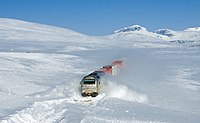
Photo from wikipedia
Wetlands are multi-functional systems that provide a disproportionate number of ecosystem services given the spatial extent they occupy both nationally and globally. The ecological functioning of these wetlands is dependent… Click to show full abstract
Wetlands are multi-functional systems that provide a disproportionate number of ecosystem services given the spatial extent they occupy both nationally and globally. The ecological functioning of these wetlands is dependent on the structure of the landscape, which poses unique challenges when reclaiming wetlands in areas where resource extraction is occurring. Resource extraction mega-projects require that entire wetlandscapes be reclaimed and often involve timelines that necessitate the consideration of climate projections to create self-sustaining, naturally appearing wetlandscapes that meet policy objectives. To understand wetlandscape structure and guide reclamation planning and closure permitting evaluation, a random sample of 13,676 1-km2 landscapes were subselected to identify 1684 permanent open-water wetlandscapes. A parsimonious set of landscape metrics were applied and compared across levels of anthropogenic disturbance and across natural regions (i.e., Grassland, Parkland and Boreal). Results demonstrated that permanent open-water wetlands are relatively rare (12.3% of our total random sample) and typically occupy less than 8% of wetlandscapes when present. The majority of wetlands in the study area are less permanent and more variable in nature than the permanent open water wetlandscapes created by megaproject reclamation, which has the potential to alter the distribution and size of open-water wetlands beyond their natural occurrence. Comparison across disturbance levels and natural regions yield statistical differences among landscape structure. General wetland landscapes representing a combination of disturbance level and natural region can be created for each metric to guide reclamation design and closure planning approval.
Journal Title: Wetlands Ecology and Management
Year Published: 2020
Link to full text (if available)
Share on Social Media: Sign Up to like & get
recommendations!